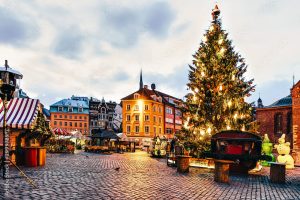Our Story
Dumbarton United Methodist Church, has been a part of Georgetown continuously since 1772, meeting first in a cooper’s shop, then on Montgomery Street (now 28th Street), and finally at the present site on Dumbarton Avenue in 1850. When the church was remodeled in 1897, the present Romanesque front was added. The stained glass windows were installed from 1898 to 1900. Inaugurated before the official creation of the Methodist Church, Dumbarton UMC is one of the oldest continuing Methodist congregations in the world.


The congregation that later became Dumbarton United Methodist Church was not Methodist, it was not a church and it was not named Dumbarton. At a barrelmakers’ shop in Georgetown, in what is now Washington, DC, a small band of faithful hosted its first permanent appointment of a traveling pastor on December 24, 1772. This group, called the Georgetown Society, was drawn to the shouting, Bible-thumping evangelism of circuit riders who traveled up and down the Potomac on horseback. They preached that rich and poor, young and old, could be saved by faith alone.
The Georgetown Society didn’t fare well during this period. Its members were affiliated with the Church of England, and John Wesley was an outspoken Tory. The Society itself was divided over independence.
The budding congregation was visited several times by Francis Asbury, the founder of Methodism in the United States. And the Montgomery Street church is where John Hersey, one of the the most important Methodist evangelists of the 19th Century, was converted
A leading early figure in the church was Henry Foxall, whose Columbia Foundry produced 300 heavy guns and 30,000 shot per year. A mayor of Georgetown and a lay preacher himself, Foxall contributed large amounts of money to support the church in Georgetown. Once he was asked about his inconsistent role of proclaimer of the gospel of peace and forger of the weapons of war. He said, “If I do make guns to destroy men’s bodies, I build churches to save their souls.”
Before the Civil War
African-Americans, some of them held in bondage by white members, were seated in the balcony of the church in the antebellum era. But many of the black members split off to form Mount Zion Church in 1813, while others continued to attend Dumbarton, which constructed the current building in 1849. When Civil War broke out, the Dumbarton congregation was deeply divided, contributing soldiers to both sides.
After the First Manassas Civil War battle, the church was converted to a hospital as thousands of casualties streamed into the city. During the war, President Abraham Lincoln visited Dumbarton for the service rededicating the church, and his pew is now engraved with the words “The Pastor.” He was said to be “much affected by the sermon, being moved to tears.” As for slaveowners, many of them were compensated by the District of Columbia for freeing their slaves by the DC Compensated Emancipation Act of 1862.
After the Civil War
After the Civil War, Dumbarton United Methodist Church continued to serve residents of Georgetown, but in 1871 Georgetown ceased to exist as a separate city and became part of Washington, DC. In 1895 the identity of Georgetown was further obliterated by the renaming of streets to fit the DC system of giving streets number or letter designations. Dumbarton Street, however, remained proudly as Dumbarton Street. And in 1898 Dumbarton United Methodist Church remodeled its building into the form seen today.
Dumbarton’s membership expanded rapidly in the late 19th century as the Methodist Episcopal Church surpassed other Protestant denominations in size. Dumbartonians joined in the camp meeting trend of out-of-town retreats to promote the religion. But Dumbarton’s growth stalled near the turn of the century as Georgetown’s industries moved to other parts of the metropolitan area and took church members with them.
Challenges
Along with the rest of the country, Dumbarton lost lives from the 1917-18 flu epidemic and World Wars I and II and also felt the impact of the Great Depression. The church helped those in need with financial and moral support. Dumbarton was also active in discouraging alcohol consumption, particularly during Prohibition. Later, as auto travel grew, many Dumbarton members moved to the suburbs and joined churches there. By 1940, the church had only 65 cents in its bank account. Membership was dwindling.
Refocus on Social Justice
No longer a neighborhood church, Dumbarton drew college students from Georgetown and nearby areas and social activists from the suburbs to renew itself. Previously nonpolitical, the church now immersed itself in civil rights marches, peace rallies and local and world affairs. A Dumbarton-performed traveling musical, “Alice In Blunderland,” highlighted nuclear disarmanent. The church became nationally known as a leader in progressive Christianity.
In 1985, Dumbarton sheltered a Salvadoran immigrant who entered the country illegally. The cause was part of the national Sanctuary Movement, in which churches defied national law by taking undocumented persons under their wings. Church members also took numerous mission trips to Latin America and Palestine to observe conditions and recommend changes.
Full Inclusion of LGBTQIA+ People
Dumbarton became a Reconciling Congregation in 1987, aligning with a national movement in the United Methodist Church welcoming LGBTQIA+ people. Many joined the church for the opportunity to worship in a congregation that welcomed all. When the District of Columbia legalized same-gender marriage in 2009, Dumbarton became the first United Methodist congregation in the city to celebrate “love and loyalty wherever they are found,” despite opposition from the larger United Methodist Church.
Becoming an Anti-Racist Church
In 2020, following the murder of George Floyd and the racial justice uprisings around the country, Dumbarton pledged to deepen our commitment to justice and inclusion and work towards becoming an Anti-Racist Church. We signed on to the pledge to embody anti-racism, acknowledging that:
- the sin of racism has been destructive to the unity of the church throughout its history;
- racism continues to cause painful division and marginalization in the church and the world;
- we shall confront and seek to eliminate racism, whether in organizations or in individuals, in every facet of the church’s life and in society at large.
Read more about the pledge to embody Anti-Racism on the Baltimore-Washington Conference webpage.
Read more about the steps we are taking to embody Anti-Racism at Dumbarton.
